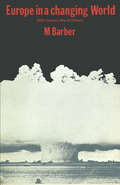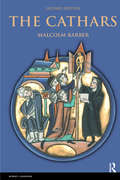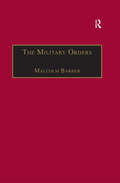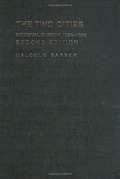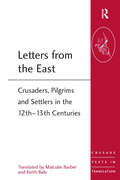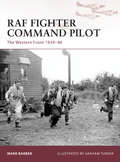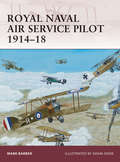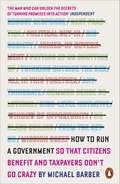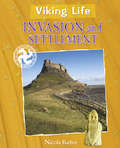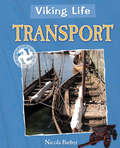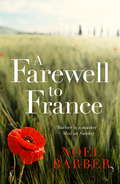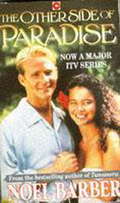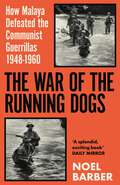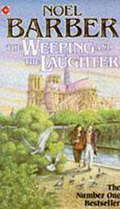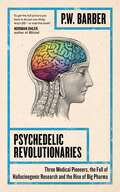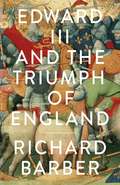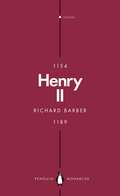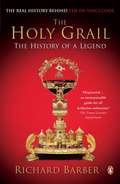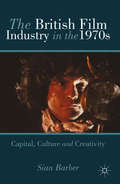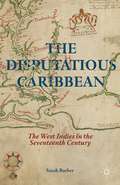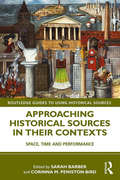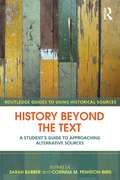- Table View
- List View
The Cathars: Dualist Heretics in Languedoc in the High Middle Ages
by Malcolm BarberIn the second half of the twelfth century, the Catholic Church became convinced that dualist heresy was taking root within Christian society and that it was particularly strong in southern France. The nature and extent of this heresy and the reaction of the Church to the perceived threat have been the focus of extensive research since the mid-nineteenth century, research which has become especially intense in the last decade. Malcolm Barber's second edition of The Cathars (which first appeared in 2000) brings readers up-to-date with the challenges to previous conclusions of recent scholarship. At the same time, the wider implications of the subject remain relevant, most importantly the fundamental questions raised by the belief in the existence of evil, the ethical problems presented by the use of coercion to suppress forms of dissent believed to threaten the social and religious fabric, and the distortion of the past to underpin present-day policies and arguments.
The Cathars: Dualist Heretics in Languedoc in the High Middle Ages (The\medieval World Ser.)
by Malcolm BarberIn the second half of the twelfth century, the Catholic Church became convinced that dualist heresy was taking root within Christian society and that it was particularly strong in southern France. The nature and extent of this heresy and the reaction of the Church to the perceived threat have been the focus of extensive research since the mid-nineteenth century, research which has become especially intense in the last decade. Malcolm Barber's second edition of The Cathars (which first appeared in 2000) brings readers up-to-date with the challenges to previous conclusions of recent scholarship. At the same time, the wider implications of the subject remain relevant, most importantly the fundamental questions raised by the belief in the existence of evil, the ethical problems presented by the use of coercion to suppress forms of dissent believed to threaten the social and religious fabric, and the distortion of the past to underpin present-day policies and arguments.
The Military Orders Volume I: Fighting for the Faith and Caring for the Sick
by Malcolm BarberThis book contains 42 papers delivered at the International Conference on Military Orders held at Clerkenwell, London, in September, 1992. There are five sections covering the Hospitallers, the Templars, the Teutonic Knights, the Spanish Orders, and the perceptions and role of the orders.The impact of the military orders on European History has been profound, both in what they achieved and in the way interpretations of these achievements have since shaped European perceptions. Their influence can be found in places as far apart as Lithuania and Andalusia, Scotland and Palestine, and their chronological range extends from their origins in the 12th century down to the present day.This importance is fully reflected in this book, where the latest research is brought together through the contributions of scholars from 13 countries.
Two Cities: Medieval Europe, 1050-1320 (PDF)
by Malcolm BarberFirst published to wide critical acclaim in 1992, The Two Citieshas become an essential text for students of medieval history. For the second edition, the author has thoroughly revised each chapter, bringing the material up to date and taking the historiography of the past decade into account. The Two Citiescovers a colourful period from the schism between the eastern and western churches to the death of Dante. It encompasses key topics such as: the Crusades the expansionist force of the Normans major developments in the way kings, emperors and Popes exercised their powers a great flourishing of art and architecture the foundation of the very first universities. Running through it all is the defining characteristic of the high Middle Ages: the delicate relationship between the spiritual and secular worlds, the two 'cities' of the title. This survey provides all the facts and background information that students need, and is defined into straightforward thematic chapters. It makes extensive use of primary sources, and makes new trends in research accessible to students. Its fresh approach gives students the most rounded, lively and integrated view of the high Middle Ages available.
Letters from the East: Crusaders, Pilgrims and Settlers in the 12th–13th Centuries (Crusade Texts in Translation)
by Malcolm Barber Keith BateNo written source is entirely without literary artifice, but the letters sent from Asia Minor, Syria and Palestine in the high middle ages come closest to recording the real feelings of those who lived in and visited the crusader states. They are not, of course, reflective pieces, but they do convey the immediacy of circumstances which were frequently dramatic and often life-threatening. Those settled in the East faced crises all the time, while crusaders and pilgrims knew they were experiencing defining moments in their lives. There are accounts of all the great events from the triumph of the capture of Jerusalem in 1099 to the disasters of Hattin in 1187 and the loss of Acre in 1291. These had an impact on the lives of all Latin Christians, but at the same time individuals felt impelled to describe both their own personal achievements and disappointments and the wonders and horrors of what they had seen. Moreover, the representatives of the military and monastic orders used letters as a means of maintaining contact with the western houses, providing information about the working of religious orders not found elsewhere. Some of the letters translated here are famous, others hardly known, but all offer unique insight into the minds of those who took part in the crusading movement.
Letters from the East: Crusaders, Pilgrims and Settlers in the 12th–13th Centuries (Crusade Texts in Translation)
by Malcolm Barber Keith BateNo written source is entirely without literary artifice, but the letters sent from Asia Minor, Syria and Palestine in the high middle ages come closest to recording the real feelings of those who lived in and visited the crusader states. They are not, of course, reflective pieces, but they do convey the immediacy of circumstances which were frequently dramatic and often life-threatening. Those settled in the East faced crises all the time, while crusaders and pilgrims knew they were experiencing defining moments in their lives. There are accounts of all the great events from the triumph of the capture of Jerusalem in 1099 to the disasters of Hattin in 1187 and the loss of Acre in 1291. These had an impact on the lives of all Latin Christians, but at the same time individuals felt impelled to describe both their own personal achievements and disappointments and the wonders and horrors of what they had seen. Moreover, the representatives of the military and monastic orders used letters as a means of maintaining contact with the western houses, providing information about the working of religious orders not found elsewhere. Some of the letters translated here are famous, others hardly known, but all offer unique insight into the minds of those who took part in the crusading movement.
The Military Orders Volume I: Fighting for the Faith and Caring for the Sick
by Malcolm Barber Peter Edbury Anthony Luttrell Jonathan Riley-SmithThis book contains 42 papers delivered at the International Conference on Military Orders held at Clerkenwell, London, in September, 1992. There are five sections covering the Hospitallers, the Templars, the Teutonic Knights, the Spanish Orders, and the perceptions and role of the orders.The impact of the military orders on European History has been profound, both in what they achieved and in the way interpretations of these achievements have since shaped European perceptions. Their influence can be found in places as far apart as Lithuania and Andalusia, Scotland and Palestine, and their chronological range extends from their origins in the 12th century down to the present day.This importance is fully reflected in this book, where the latest research is brought together through the contributions of scholars from 13 countries.
RAF Fighter Command Pilot: The Western Front 1939–42 (Warrior #164)
by Mark BarberThe recent 70th anniversary of the Battle of Britain, combined with the threat of significant cuts to the current RAF, have highlighted the importance of Fighter Command in the early days of World War II once more. The role of the “few”, as described by Churchill, during the Battle of Britain has been the subject of much mythologizing both at the time and in the years since. This title will put Fighter Command in context; describing the lack of funding and attention which it received during the interwar period, until it was almost too late. The myth of the fighter pilot will be humanized, with first-hand accounts quoted which put nervous but brave human beings from all walks of life in the cockpit. Although the Battle of Britain may not have in itself been the decisive encounter that it has historically been portrayed as, the moral victory won by the RAF, the victory that proved that Germany could be defeated, was just as important as a military-strategic victory.
Royal Naval Air Service Pilot 1914–18 (Warrior #152)
by Mark Barber Mr Adam HookIn 1914 the Naval Wing of the Royal Flying Corps was subsumed into the Royal Naval Air Service (RNAS). With the bulk of the Royal Flying Corps engaged in France, the aircraft and seaplane pilots of the RNAS protected Britain from the deadly and terrifying Zeppelin menace. In 1915 the RNAS sent aircraft to support the operations in the Dardanelles, and also gave increasing support to the Royal Flying Corps units engaged on the Western Front, conducting reconnaissance, intelligence gathering and artillery spotting, bombing raids, and aerial combat with German pilots. This book explores all of these fascinating areas, and charts the pioneering role of the RNAS in military aviation.
How to Run A Government: So that Citizens Benefit and Taxpayers Don't Go Crazy
by Michael BarberBillions of citizens around the world are frustrated with their governments. Why is this? And what can we do about it? In this groundbreaking book Michael Barber draws on his wealth of international experience advising political leaders, to show how those in power can make good on their promises. 'Refreshingly ruthless ... has an uplifting brio to it' Economist'Michael Barber is a source of inspiration and wisdom' Andrew Adonis, New Statesman'Excellent ... there is a lot of common sense and practical wisdom ... a breath of fresh air' David Willetts,Standpoint'Barber is the global overlord of public policy ... a record around the world of actually achieving change' Philip Collins, Prospect
Invasion and Settlement: Invasion And Settlement (Viking Life)
by Nicola BarberThe Viking Life series explores the everyday lives of people who lived during the Viking era. This title looks at Viking invasion and settlement, describing how far Viking travels extended and how the Vikings attacked, fought against or traded with the people they encountered.
Transport: Transport (Viking Life)
by Nicola BarberThe Viking Life series explores the everyday lives of people who lived during the Viking era. This title looks at the Vikings built and travelled in longships and other forms of transport across water and land. It describes how the Vikings' use of transport enabled them to carry out raiding and trading expeditions and examines evidence ship burials.
A Farewell to France
by Noel BarberSonia Riccardi, impetuous and sensual, is a woman no man could resist. And Larry Astell, heir to a champagne fortune, knows their passion is the most important part of his life. Until war places in jeopardy all they held dear - love, family and country.From the Left Bank of the 1930s to Nazi-occupied Paris, A FAREWELL TO FRANCE is a magnificent epic, played out against the tumultuous background of the time: a decadent French government, the life of a foreign correspondent, the grandeur of the champagne regions and the glory of the French Resistance.
The Other Side of Paradise
by Noel BarberWhen pioneering doctor Kit Masters is forced to flee England, he makes a new start on the South Sea island of Koraloona. Enchanted by the island and its people, Kit falls in love with Gaugin's grandaughter and dreams of building a hospital. But all is under threat as World War II approaches. 'Barber is a master' Mail on Sunday
The War of the Running Dogs: Malaya 1948-1960 (Sven Hassel War Classics)
by Noel Barber'The story of the first all-out struggle in Asia between Communism and the West, vividly told in an exciting and engrossing book' Sunday ExpressOnly three short years after the end of the Japanese occupation, war came again to Malaya. The Chinese-backed guerrillas called it the War of the Running Dogs - their contemptuous term for those in Malaya who remained loyal to the British. The British Government referred to this bloody and costly struggle as the 'Malayan Emergency'. Yet it was a war that lasted twelve years and cost thousands of lives. By the time it was over Malaya had obtained its independence - but on British, not on Chinese or Communist terms. Here is the war as it was. Here are the planters and their wives on their remote rubber estates, the policemen, the generals and the soldiers, the Malays, Chinese and Indians of a polyglot country, all fighting an astute, ruthless, and well organized enemy.
The Weeping and the Laughter (Coronet Bks.)
by Noel BarberThis story describes the dramatic lives of Prince Dmitri Korolev and his family caught up in the upheavals of European revolution and war. They flee Russia in 1919, escape to Switzerland and then Paris, but, with the Second World War, they come under further pressure from the Communist police. The author worked for many years in Paris as a foreign correspondent and wrote several novels including "Tanamera", "A Farewell to France", "A Woman of Cairo" and "The Other Side of Paradise".
Psychedelic Revolutionaries: Three Medical Pioneers, the Fall of Hallucinogenic Research and the Rise of Big Pharma
by P.W. BarberThe post-World War II era was a tumultuous period in the world of psychiatry. Medical history has cast it as a clash between biology and psychoanalysis or as a time that lacked objectivism, that is until the introduction of psychotropic drugs such as chlorpromazine which triggered a change in our treatment of mental health as profound and far-reaching in its consequences as the war itself. In the early years of this psychopharmacological revolution, hallucinogens such as mescaline and LSD played as much of a role as other psychotropics. In fact, psychedelics constituted a scientific revolution in their own right, one that does not however fit the narrative of twentieth century scientific history.Looking beyond the countercultural manifestations and references that have for decades obfuscated the psychedelic story, historian P.W. Barber delves into a serious examination of both the science and the people behind the research. Showing why and how this experimentation unfolded, what its findings were and how these findings were received both within and outside the scientific community, Psychedelic Revolutionaries completely resets a long-misunderstood history by following the work of three pioneering psychiatrists - Humphry Osmond, who coined the term 'psychedelic' and administered Aldous Huxley his first dose of mescaline, Abram Hoffer and Duncan Blewett, also known as the 'Leary of the North'. While considering how it is that scientific discoveries become accepted as established truths, Barber invites us to ask: what is it that makes a scientific discovery revolutionary?
Edward III and the Triumph of England: The Battle of Crécy and the Company of the Garter
by Richard BarberA fascinating recreation of the world of one of England's most charismatic monarchs, from award-winning author and historian Richard BarberThe destruction of the French army at Crécy in 1346 and the subsequent siege and capture of Calais marked a new era in European history. The most powerful, glamorous and respected of all western monarchies had been completely humiliated by England, a country long viewed either as a chaotic backwater or a mere French satellite.The young Edward III's triumph would launch both countries, as we now know, into a grim cycle of some 90 years of further fighting ending with English defeat, but after Crécy anything seemed possible - Edward's claim to be King of France could be pressed home and, in any event, enormous rewards of land, treasure and prestige were available both to the king and to the close companions who had made the victory possible. It was to enshrine this moment that Edward created one of the most famous of all knightly orders, the Company of the Garter.Barber writes about both the great campaigns and the individuals who formed the original membership of the Company - and through their biographies makes the period tangible and fascinating. This is a book about knighthood, battle tactics and grand strategy, but it is also about fashion, literature and the privates lives of everyone from queens to freebooters. Barber's book is a remarkable achievement - but also an extremely enjoyable one.Reviews:'Barber [has an] infectious passion for and deep knowledge of his subject matter ... elegant prose and rigorous historical analysis ... a valuable and thorough addition to the body of work on this most impressive of English monarchs' Sunday Times'In Edward III and the Triumph of England [Barber] has written the kind of book that the king would have enjoyed: full of battles, glitter and ceremony ... he has an original eye and an elegant pen' Jonathan Sumption, Literary Review'Barber share's his hero's love of chivalry ... The book sparkle[s] with some of Edward's own glitz' Telegraph'This absorbing book is layered rather than linear, sifting with uncommon sensitivity through challenging sources to test the boundaries of what we can and cannot know ... We discover the complexity of the world in which Edward and his commanders lived' Helen Castor, The TimesAbout the author:Richard Barber has had a huge influence on the study of medieval history and literature, both as a writer and as a publisher. His major works include The Knight and Chivalry (winner of the Somerset Maugham Award), Edward Prince of Wales and Aquitaine, The Penguin Guide to Medieval Europe and The Holy Grail: The History of a Legend. He lives in East Anglia.
Henry II: A Prince Among Princes (Penguin Monarchs #17)
by Richard BarberHenry II (1154-89) through a series of astonishing dynastic coups became the ruler of an enormous European empire. One of the most dynamic, restless and clever men ever to rule England, he was brought down both by his catastrophic relationship with his archbishop Thomas Becket and his debilitating arguments with his sons, most importantly the future Richard I and King John. His empire may have ultimately collapsed, but in Richard Barber's vivid and sympathetic account the reader can see why Henry II left such a compelling impression on his contemporaries.
The Holy Grail: The History of a Legend
by Richard BarberThe Holy Grail is an image familiar to us all as an almost unattainable, infinitely desirable goal. The idea has passed into everyday speech and the legends behind it are as current in today's culture as they have ever been. And yet the Grail has no real religious meaning and is nowhere mentioned in the Bible. What is the truth behind this elusive symbol? Here, Barber traces the history of the stories surrounding the Holy Grail. He describes how through a long series of imaginative transformations, the grail has moved from the sphere of romance to religion, and in twentieth century popular culture has become an emblem of mysticism and man's highest aspirations, intimately linked with the central ritual of the Christian faith. The search for the grail has always been described as a quest; in this book, Barber goes on his own quest, brilliantly exploring the richness of the Holy Grail's cultural impact. Barber traces the history of legends surrounding the Holy Grail, from Chretien de Troyes' great romances to the popular bestsellers of the late twentieth century.
The British Film Industry in the 1970s: Capital, Culture and Creativity
by S. BarberIs there more to 1970s British cinema than sex, horror and James Bond? This lively account argues that this is definitely the case and explores the cultural landscape of this much maligned decade to uncover hidden gems and to explode many of the well-established myths about 1970s British film and cinema.
The Disputatious Caribbean: The West Indies in the Seventeenth Century
by S. BarberThis history of the 'Torrid Zone' offers a comprehensive and powerfully rich exploration of the 17th century Anglophone Atlantic world, overturning British and American historiographies and offering instead a vernacular history that skillfully negotiates diverse locations, periodizations, and the fraught waters of ethnicity and gender.
Approaching Historical Sources in their Contexts: Space, Time and Performance (Routledge Guides to Using Historical Sources)
by Sarah Barber Corinna M. Peniston-BirdIn Approaching Historical Sources in Their Contexts, 12 academics examine how space, time and performance interact to co-create context for source analysis. The chapters cover 2000 years and stretch across the Americas and Europe. They are grouped into three themes, with the first four exploring aspects of movement within and around an environment: buildings, the tension between habitat and tourist landscape, cemeteries and war memorials. Three chapters look at different aspects of performance: masque and opera in which performance is (re)constructed from several media, radio and television. The final group of chapters consider objects and material culture in which both spatial placement and performance influence how they might be read as historical sources: archaeological finds and their digital management, the display of objects in heritage locations, clothing, photograph albums and scrapbooks. Supported by a range of case studies, the contributors embed lessons and methodological approaches within their chapters that can be adapted and adopted by those working with similar sources, offering students both a theoretical and practical demonstration of how to analyse sources within their contexts. Drawing out common threads to help those wishing to illuminate their own historical investigation, this book encourages a broad and inclusive approach to the physical and social contexts of historical evidence for those undertaking source analysis.
History Beyond the Text: A Student’s Guide to Approaching Alternative Sources
by Sarah Barber Corinna Peniston-BirdHistorians are increasingly looking beyond the traditional, and turning to visual, oral, aural, and virtual sources to inform their work. The challenges these sources pose require new skills of interpretation and require historians to consider alternative theoretical and practical approaches. In order to help historians successfully move beyond traditional text, Sarah Barber and Corinna Peniston-Bird bring together chapters from historical specialists in the fields of fine art, photography, film, oral history, architecture, virtual sources, music, cartoons, landscape and material culture to explain why, when and how these less traditional sources can be used. Each chapter introduces the reader to the source, suggests the methodological and theoretical questions historians should keep in mind when using it, and provides case studies to illustrate best practice in analysis and interpretation. Pulling these disparate sources together, the introduction discusses the nature of historical sources and those factors which are unique to, and shared by, the sources covered throughout the book. Taking examples from around the globe, this collection of essays aims to inspire practitioners of history to expand their horizons, and incorporate a wide variety of primary sources in their work.
